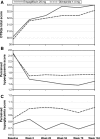Treatment satisfaction in type 2 diabetes patients taking empagliflozin compared with patients taking glimepiride
- PMID: 26424170
- PMCID: PMC4840220
- DOI: 10.1007/s11136-015-1140-2
Treatment satisfaction in type 2 diabetes patients taking empagliflozin compared with patients taking glimepiride
Abstract
Purpose: This exploratory analysis assessed and compared patients' treatment satisfaction with empagliflozin plus metformin versus glimepiride plus metformin, using data obtained from the Diabetes Treatment Satisfaction Questionnaire, status version (DTSQs) collected in a randomized, double-blind, double-dummy clinical trial.
Methods: Observed values for DTSQs scale score and each of its eight items were summarized by visit and treatment arm. Changes from baseline in these scores were analyzed using linear mixed models for repeated measures.
Results: The baseline scale score and item scores were comparable between empagliflozin plus metformin (n = 765) and glimepiride plus metformin (n = 780). Compared with baseline, patients reported significant treatment satisfaction increases and significant decreases in perceived hyperglycemia with both treatments at all visits. Also, compared with baseline, a significant increase in perceived frequency of hypoglycemia was observed in the glimepiride treatment group at all visits. No statistically significant treatment difference was observed in DTSQs scale score and its items at week 104. The difference between the treatment groups was significant and in favor of empagliflozin from week 28 onward for perceived frequency of hyperglycemia (P ≤ 0.006) and perceived frequency of hypoglycemia (P ≤ 0.011).
Conclusions: Despite positive trends in favor of empagliflozin, there was no significant difference in DTSQs scale score between empagliflozin and glimepiride at 104 weeks. However, when compared with glimepiride, empagliflozin demonstrated significantly lower perceived frequency of hyperglycemia and hypoglycemia at all visits from week 28 onward. This finding is consistent with the clinical results reported for the EMPA-REG H2H-SU trial.
Keywords: Diabetes Treatment Satisfaction Questionnaire; Empagliflozin; Glimepiride; Type 2 diabetes mellitus.
Figures
References
-
- International Diabetes Federation. (2013). IDF diabetes atlas (6th ed.). http://www.idf.org/sites/default/files/EN_6E_Atlas_Full_0.pdf. Accessed 26 Nov 2014.
-
- Bradley C, Gamsu DS. Guidelines for encouraging psychological well-being: Report of a working group of the World Health Organization Regional Office for Europe and International Diabetes Federation European Region St Vincent Declaration Action Programme for Diabetes. Diabetic Medicine. 1994;11:510–516. doi: 10.1111/j.1464-5491.1994.tb00316.x. - DOI - PubMed
Publication types
MeSH terms
Substances
LinkOut - more resources
Full Text Sources
Other Literature Sources
Medical


